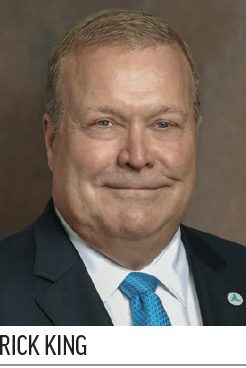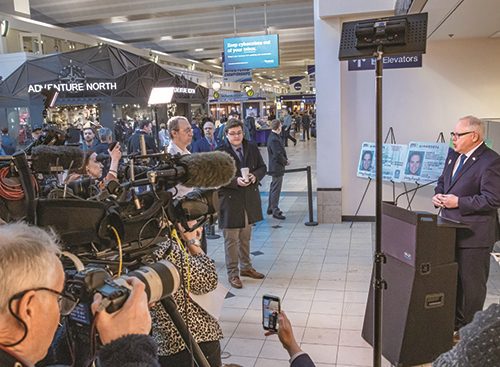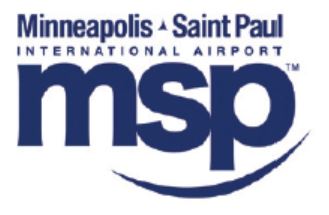A can-do attitude gets things done, and that’s definitely the mindset of Rick King, chair of Minnesota’s Metropolitan Airports Commission. In early January, after learning that less than 11% of Minnesotans had their REAL IDs, King began researching solutions.
A can-do attitude gets things done, and that’s definitely the mindset of Rick King, chair of Minnesota’s Metropolitan Airports Commission.
 In early January, after learning that less than 11% of Minnesotans had their REAL IDs, King began researching solutions. The low participation rate concerned him, because at the time of his research, adult U.S. citizens could not fly without a REAL ID, passport, or military ID as of Oct. 1, 2020.
In early January, after learning that less than 11% of Minnesotans had their REAL IDs, King began researching solutions. The low participation rate concerned him, because at the time of his research, adult U.S. citizens could not fly without a REAL ID, passport, or military ID as of Oct. 1, 2020.
Even though the federal government has since extended the REAL ID deadline to Oct. 1, 2021, King still sees the need for airports to do more.
|
facts&figures Project: Preparing for REAL ID Deadline
Strategy: Open REAL ID Application Office Cost: Nominal (terminal space; existing desks & kiosks; electrical service) Key Benefit: Passengers can apply for REAL IDs at in-airport station staffed by state Driver & Vehicle Services Div. Timeline: Development began in January; office opened in early March, but closed a few weeks later during COVID-19 pandemic
Strategy: Provide space in terminal for DMV employees to distribute info about REAL ID requirements & issue “fast track” passes for expedited service at local DMVs Key Benefit: Speeds application process for travelers & airport staff
Strategy: Host press conference to publicize REAL ID deadline Timeline: Oct. 1, 2019 |
“I just picture my mother or grandmother trying to go to a loved one’s wedding or christening and being unable to do so because she didn’t have the right identification,” relates King. “We need to ask the question: How can we prevent this? How can we up the number of REAL IDs faster?”
Ultimately, he developed the answers at Minneapolis-St. Paul International Airport (MSP). “Why not capitalize on the time people spend at the airport? It makes perfect sense to set up a licensing area at the airport,” King explains.
Just two months later, Minnesota travelers flying out of MSP were able to save time and avoid going to the state Department of Motor Vehicles (DMV) by applying for a REAL ID at the airport. MSP partnered with the Minnesota Department of Public Safety’s Driver and Vehicle Services Division, and a REAL ID office opened inside Terminal 1 on March 2.
While many airports distribute information about REAL IDs, King isn’t aware of any other airports that offer REAL ID licensing on site.
“It just makes sense to have a Driver and Vehicle Services station at the airport,” he says. “It gives us another way to educate passengers about REAL ID and allows travelers to plan ahead and apply for a compliant ID the next time they fly.”
Minnesota travelers seemed to agree. The station at MSP booked 150 appointments and processed 55 applications in its first week. “We even had one of our U.S. senators stop by and get her real ID,” King reports.
The onsite option also proved popular with employees. “Over 21,000 people work at the airport every day,” he notes. “We saw a lot of them lining up to get their IDs while they were at work.”
The state DMV recently shuttered the airport application center amid coronavirus concerns, and as of press time in April, King is unsure if or when the office will reopen. Even so, it is an excellent example of how airports can help residents obtain REAL IDs.
A REAL (ID) Problem
MSP’s concerns rose out of the REAL ID Act, which will now take effect on Oct. 1, 2021. That’s when every air traveler 18 years of age and older will need a REAL ID-compliant driver’s license, state-issued ID, or another acceptable form of ID, such as a passport or military ID, to fly within the United States.
The change stems from the 2005 REAL ID Act, which established stringent standards for identity documents such as driver’s licenses and state-issued IDs to make them more consistent and secure. It also prohibits federal agencies, including TSA, from accepting licenses and identification cards that do not meet the law’s strict guidelines.

The legislation arose out of the Sept. 11 tragedies, when terrorists used domestic planes to commit crimes against the U.S. Congress passed the REAL ID Act to help prevent airline terrorism by increasing the documentation requirements to obtain acceptable identification. Today, a citizen must prove his or her name and date of birth, legal presence in the U.S., name change (if applicable), Social Security number, and address. States also now use new technologies to make ID forgeries more difficult.
Brian Kulpin, head of the MarCom committee for Airports Council International – North America (ACI-NA), reports that airport leaders are not questioning the legislation’s rationale. Further, Kulpin personally commends the government for its efforts to “put the safety and security of our country first.”
That said, he also thinks that Congress dropped the ball after passing the law. “They put very little money behind the communications effort for REAL ID,” Kulpin explains. “If you pass regulations that change things so drastically, you must educate the population, too. We’re not seeing enough educational efforts at the federal level; they left it to the individual states, airlines and airports. That’s just not good policy.”
Recent statistics back up his concerns. Heading into the new year, the U.S. Department of Homeland Security (DHS) announced that states had issued just 34% of the 276 million possible total IDs.
“We see people who already have their REAL ID. We see those who are aware there is a change and still need to do something. And, we see people who have no idea REAL ID is coming because the message hasn’t reached them yet,” Kulpin says. “We need to educate people as fast as possible to avoid total chaos next year.”
By early March, it was estimated that 40% of Americans still did not have REAL IDs—a number Kulpin found unacceptable. With about 2.4 million passengers flying in the U.S. every day, that would mean 960,000 people would be unable to fly in 2021 if the adoption rate doesn’t improve and they don’t have a passport or military ID.
“Our country needs people to travel; it is vital for our culture. To deny citizens the ability to fly isn’t good for anyone,” he emphasizes. “If we have thousands of people across the country unable to fly when the deadline hits, it would be a customer service nightmare for airports, the TSA and the airlines. And it would hurt the economy of our country. We must spread the word, so people get their REAL IDs.”
TSA & Airline Response
Affected stakeholders—from TSA and airlines to airports, DMVs and industry organizations—are taking action to move the needle in the right direction.
“The TSA has been very aggressive in reaching out to the public on REAL ID,” says Lisa Farberstein, a media spokesperson for the federal agency. Efforts include informational press conferences across the country, state-specific press releases, detailed information at www.tsa.gov and messaging on social media such as Twitter and Instagram. In-airport efforts by TSA include posting signs in checkpoint lines and at travel/document-checking podiums.
“And, TSA officers are reminding passengers by providing verbal advertisements when they come to checkpoints without a REAL ID,” notes Farberstein.
Elise Durham, director of the Office of Policy and Communications at Hartsfield-Jackson Atlanta International Airport, considers the TSA very engaged in educating the traveling public. “They did a gaggle with reporters in Atlanta a couple of months ago, and at that time Georgia was above 80% compliant,” says Durham.
Airlines for America (A4A) is supplementing TSA’s efforts by partnering with travel industry stakeholders, government officials, airlines and airports to form a coalition that conducts robust outreach and public awareness campaigns about the topic. It is also working on a contingency plan.
“The coalition is encouraging the TSA and government to develop operational strategies that accommodate those passengers that show up without a REAL ID next year,” says A4A Vice President of Security and Facilitation Lauren Beyer. “The answer cannot be that they cannot fly.”
For its part, A4A developed uniform messaging for travel-related stakeholders to use and asked state governors to join its awareness campaigns. The association’s REAL ID Toolkit encourages concise and consistent messaging, and includes a hashtag, tagline, editable blogs and opinion pieces, email marketing materials, factsheets, infographics, radio scripts and talking points. Beyer describes the toolkit as a “plug and play” outreach program that is not only available to member airlines, but also airports, DMVs and travel partners.
 A4A also launched the realidfacts.com website, where travelers can learn more about the REAL ID and find specific requirements for their particular states.
A4A also launched the realidfacts.com website, where travelers can learn more about the REAL ID and find specific requirements for their particular states.
“We’re very pleased that the issue is getting more and more attention,” Beyer says. “Our member airlines are also doing things to reach their customers. They’ve updated their websites, posted notices on social media, put REAL ID messaging on inflight entertainment systems and magazines, and have added REAL ID alerts to their reservation confirmation emails.”
Airports Doing Their Part
When MSP’s King called the Minnesota Department of Public Safety in early January, the commissioner immediately agreed to his suggestion about processing REAL ID applications at the airport. And King quickly assigned key airport staff to head the effort.
The airport not only provided the department with space in the MSP Mall near the entrance to Concourse G, it also furnished desks and kiosks from storage and hired electricians to provide power to the area. “We located the space opposite one of the highest-grossing restaurant/bars in the airport,” King notes.
Besides setting up the station, MSP paid to provide parking and badge credentials for three state employees who staff it. King considers the total expense to be minimal and the benefits to be valuable. Costs for the Department of Public Safety’s Driver and Vehicle Services Division were also low. It simply reassigned three employees to the airport and used existing equipment to process applications.
The site was open from 8 a.m. to 5 p.m. Monday through Friday until the state shut it down during the COVID-19 crisis. When open, the center served three purposes: educating the public about REAL ID, informing Minnesota residents about getting their IDs at the airport, and processing REAL ID applications. “They gave out a little card with their phone number and website on it,” King says. “People booked an appointment online and pre-registered their documents. They planned their visit for the next time they flew. The entire process took about 12 minutes when they came in with the right documentation.” The state then sent applicants their REAL IDs via mail.
MSP promotes the new station with signage throughout the airport, and the airlines inform passengers via email as they book tickets, at the ticketing counter and with on-board announcements. The station’s opening, which was attended by the state’s governor, was covered by numerous press outlets.

King highlights the cooperation that occurred among state agencies that are otherwise somewhat monolithic. “We collaborated and worked together, and that is why the station opened so quickly,” he reflects.
Though other airports are not processing ID applications on-site, they are helping spread the word. At Reno-Tahoe International Airport (RNO), where Kulpin serves as vice president of marketing and public affairs, passengers are receiving information about REAL ID Monday through Friday from Nevada DMV employees. Travelers and badged employees who stop at the information desk receive a “fast track pass” that vaults them to the front of DMV lines to apply for REAL IDs.
RNO also partnered with a marketing agency to produce informational materials about REAL ID. “In exchange for their work, we give them free space on our TV channels,” Kulpin says. “Partnering with your DMV helps get messaging in front of passengers. Partnerships like the one with the marketing agency and Clear Channel mean there is little cost for any of these efforts.”
Doug Nick, assistant communications director for customer outreach at the Arizona Department of Transportation, reports similar programs at Phoenix Sky Harbor Airport (PHX). Efforts there began Oct. 1, 2019, (a full year before the original deadline) with a government-sponsored press conference at the airport.
“There was a spike in REAL IDs after that press conference,” reports Nick. “The airport and TSA also put up signage at the airport and printed flyers to distribute. And, the DOT hired two temporary workers to man an information desk at the busiest terminal from 6 a.m. to 2 p.m.”
He adds that Tucson International Airport, Flagstaff Airport, Yuma International Airport and Phoenix Mesa Gateway Airport are proactively trying to reach leisure travelers with digital ads and informational leaflets in their terminals.
 “Leisure travelers are a real problem,” Nick says, noting that they are more likely than business travelers to be unaware of the change. The difference is especially pronounced at PHX because Arizona is the only state where motorists do not have to renew their driver’s licenses until age 65. “We encourage motorists to get a new photo taken every 12 years, but there is no enforcement mechanism for that. We cannot suspend their driver’s license or anything like that if they don’t do it,” he explains.
“Leisure travelers are a real problem,” Nick says, noting that they are more likely than business travelers to be unaware of the change. The difference is especially pronounced at PHX because Arizona is the only state where motorists do not have to renew their driver’s licenses until age 65. “We encourage motorists to get a new photo taken every 12 years, but there is no enforcement mechanism for that. We cannot suspend their driver’s license or anything like that if they don’t do it,” he explains.
Despite multiple outreach efforts, Nick feels that Arizona has a ways to go to meet the new deadline. “The current numbers say we’ve issued 850,000 Arizona Travel IDs [Arizona’s name for REAL IDs]. This is a tiny number compared to the 5½ million driver’s licenses active in the state and the other million non-operator IDs we have. Just 67% of the new licenses we issue comply with the new requirements.”
Other airports will have hurdles to clear that are unique to their particular markets. For instance, RNO and Cincinnati/Northern Kentucky International Airport each routinely serve passengers from two states, so they must educate citizens in both. Airports that serve large bilingual populations or groups who lack proper documents will face associated challenges as their states transition residents to REAL IDs.
“We are trying to make flying more secure, but we cannot make it so difficult that the good citizens of the United States cannot travel,” Kulpin remarks.
12-Month Reprieve
In February, the DHS began allowing states to electronically accept documents for REAL ID applications.
The change was instituted to speed up processing at DMVs, which were experiencing lengthy lines and wait times before the COVID-19 shutdown. But Nick, from Arizona’s Department of Transportation, is not optimistic about the online option. “We still need to see physical documents when you come in,” he explains. “Electronic submissions do little to change the transaction times and little to boost the numbers of Americans getting their REAL IDs.”
ACI-NA asked the government to extend the original 2020 deadline, citing significant concerns about the low saturation of REAL ID-compliant identification among the traveling public and the negative impacts that will cause. Then the COVID-19 crisis essentially sealed the deal. When the $2 trillion Coronavirus Aid, Relief and Security (CARES) Act was signed into law on March 27, it included a provision that delays full implementation of the REAL ID until Oct. 1, 2021.
Importantly, the CARES Act delays—not eliminates—the deadline. The country now has 12 more months to get its REAL ID act together. Though airports are breathing a collective sigh of relief over the extra time, King says the industry must continue to charge ahead to make sure it can meet the new Oct. 1, 2021, deadline.






